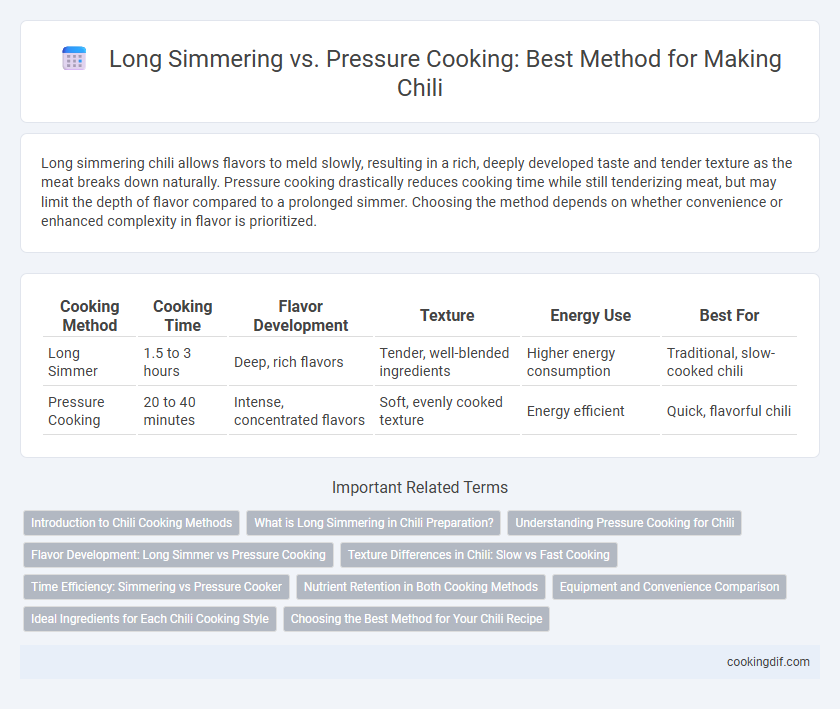Long simmering chili allows flavors to meld slowly, resulting in a rich, deeply developed taste and tender texture as the meat breaks down naturally. Pressure cooking drastically reduces cooking time while still tenderizing meat, but may limit the depth of flavor compared to a prolonged simmer. Choosing the method depends on whether convenience or enhanced complexity in flavor is prioritized.
Table of Comparison
| Cooking Method | Cooking Time | Flavor Development | Texture | Energy Use | Best For |
|---|---|---|---|---|---|
| Long Simmer | 1.5 to 3 hours | Deep, rich flavors | Tender, well-blended ingredients | Higher energy consumption | Traditional, slow-cooked chili |
| Pressure Cooking | 20 to 40 minutes | Intense, concentrated flavors | Soft, evenly cooked texture | Energy efficient | Quick, flavorful chili |
Introduction to Chili Cooking Methods
Long simmering chili develops rich, deep flavors as the slow heat breaks down tough cuts of meat and blends spices thoroughly. Pressure cooking significantly reduces cooking time while tenderizing ingredients effectively, preserving robust taste and moisture. Both methods enhance chili's texture and complexity, with choice depending on available time and desired flavor intensity.
What is Long Simmering in Chili Preparation?
Long simmering in chili preparation involves cooking the ingredients slowly over low heat for several hours, allowing flavors to meld deeply and the meat to become tender. This method enhances the development of complex taste profiles by breaking down collagen and integrating spices thoroughly. Slow simmering contrasts with pressure cooking by prioritizing gradual flavor infusion over rapid cooking times.
Understanding Pressure Cooking for Chili
Pressure cooking chili dramatically reduces cooking time by reaching elevated temperatures that break down tough meat fibers and meld flavors faster than long simmer methods. This technique preserves more nutrients and intensifies spices by trapping steam and flavors under high pressure, resulting in a rich, tender chili with consistent texture. Cooking chili in a pressure cooker typically takes 30 to 45 minutes, compared to several hours required by traditional slow simmering.
Flavor Development: Long Simmer vs Pressure Cooking
Long simmering chili allows complex flavors to deepen gradually as the diverse spices and ingredients meld over time, resulting in a rich, well-rounded taste profile. Pressure cooking significantly reduces cooking time while still extracting robust flavors but may not achieve the same nuanced depth or tender texture as the prolonged simmer. Flavor compounds like Maillard reactions and slow collagen breakdown develop more thoroughly in long simmer methods, enhancing chili's savory intensity.
Texture Differences in Chili: Slow vs Fast Cooking
Slow cooking chili through long simmering allows flavors to deepen and meat to become tender with a melt-in-your-mouth texture, while pressure cooking speeds up the process, producing a softer, but sometimes less developed texture. Slow simmering breaks down connective tissues gradually, creating a rich, hearty consistency and enhanced complexity in beans and vegetables. In contrast, pressure cooking tenderizes ingredients quickly but may result in softer beans and a less pronounced melding of flavors, affecting the overall mouthfeel of the chili.
Time Efficiency: Simmering vs Pressure Cooker
Long simmering chili requires 2 to 3 hours on low heat to fully develop deep flavors and tenderize tough cuts of meat. Pressure cooking reduces this time drastically to about 30 to 45 minutes, using high pressure to break down ingredients quickly while preserving moisture and enhancing taste. Pressure cookers offer optimal time efficiency without compromising the rich texture essential in traditional chili recipes.
Nutrient Retention in Both Cooking Methods
Long simmering chili allows flavors to meld deeply but results in greater nutrient loss, especially heat-sensitive vitamins like vitamin C and some B vitamins. Pressure cooking significantly reduces cooking time, preserving more nutrients by limiting exposure to prolonged heat and oxygen. Both methods enhance flavor, yet pressure cooking optimizes nutrient retention, making it a healthier choice for preparing chili.
Equipment and Convenience Comparison
Pressure cooking chili significantly reduces cooking time to about 30-40 minutes compared to the several hours required for long simmering, making it ideal for busy kitchens. Equipment-wise, a pressure cooker requires initial investment and careful monitoring of sealing and pressure levels, while a slow cooker or stovetop pot used for long simmering offers more straightforward handling without pressure risks. Convenience factors favor pressure cooking for quick meals with retained flavors, whereas long simmering enhances depth of flavor through gradual heat, demanding more active or extended cooking time.
Ideal Ingredients for Each Chili Cooking Style
Long simmer chili benefits from hearty ingredients like beef chuck, dried beans, and whole tomatoes, which require extended cooking to break down and meld flavors. Pressure cooking suits tougher meats such as pork shoulder and kidney beans with a firmer texture, reducing cook time while retaining depth. Aromatics like onions, garlic, and chili powders are essential in both methods for developing rich, complex flavors.
Choosing the Best Method for Your Chili Recipe
Long simmering chili enhances flavor by allowing spices and ingredients to meld slowly over hours, creating a rich, complex taste and tender texture. Pressure cooking drastically reduces cooking time while still tenderizing meat effectively, making it ideal for quick meals without sacrificing depth. Choose long simmering for traditional, deeply developed flavors; opt for pressure cooking when time efficiency is essential.
Long simmer vs pressure cooking for method Infographic

 cookingdif.com
cookingdif.com